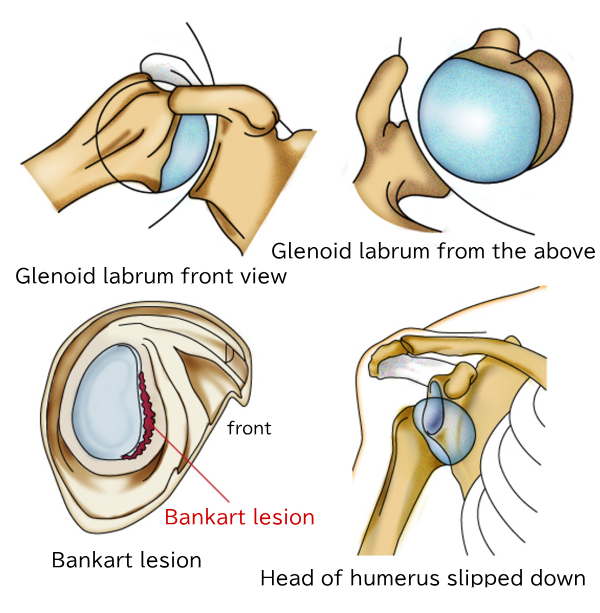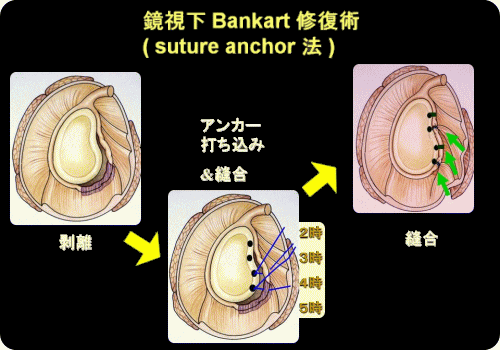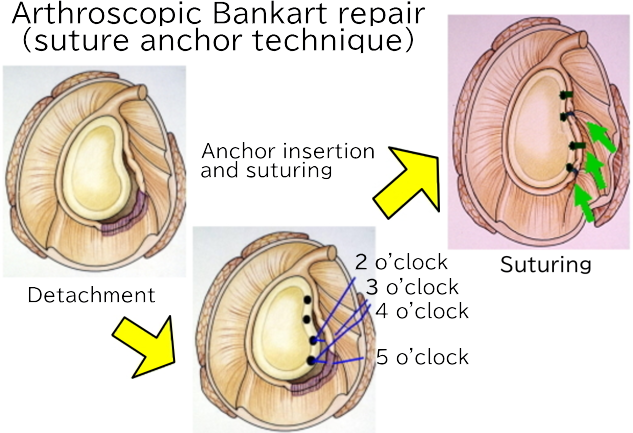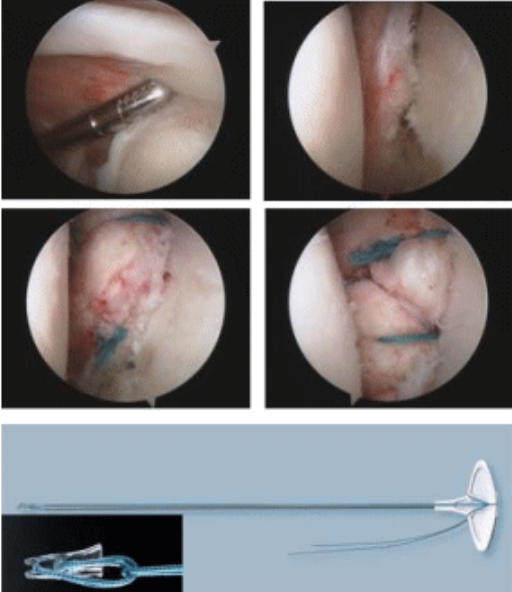Recurrent dislocated shoulder
Mechanism of onset
It happens when your upper arm pops out of the shoulder socket by falling onto an outstretched hand, having an accident, another sudden injury and making certain movements in sports.
Symptoms
・Progressive weakness of the shoulder、feeling loose shoulder
・Dull deep ache/pain or cracking sound when the joint or the arm is moved in certain ways
・Shoulder imbalance
・Difficulty to raise the arm
Bankart lesion is a tear of the glenoid labrum due to recurrent dislocation of shoulder joint. During the shoulder dislocation, fibers in the capsule can pull on the labrum and cause it to tear. Usually, the shoulder joint is surrounded by a sheet of ligaments and other tough fibers to keep the humerus stable and centralized within the socket. However, once the labrum is torn, these is a greater chance for the humerus to slip out of its socket.

Treatments
Surgery: Open surgery or Arthroscopic Bankart repair to reattach and tighten the detached labrum within the should joint
Physical therapy: use of slings, exercise to restore the range of motion of the shoulder joint, and to regain muscle control, strength and joint function.
Rehabilitation exercises: to understand the right posture to avoid recurrent dislocations, and to strengthen joint and core muscles to improve body stability.
どんな病気?What kind of illness?
肩の脱臼が何度もおこる病気です。
This is a condition where the shoulder dislocates repeatedly.
Main symptoms
・肩が抜けそうな感じがする、嫌な感じがあり,怖くて腕を挙げれない
・脱臼した瞬間に強い痛みが生じ、音がすることもある
・肩の形状に左右差が生じることもある
・痛みにより手を挙げられなくなる
Feeling like the shoulder might slip out, an unpleasant sensation that makes it frightening to raise the arm.
Intense pain occurs at the moment of dislocation, sometimes accompanied by a sound.
There may be a noticeable asymmetry in shoulder shape.
Pain prevents the arm from being raised.
反復性肩関節脱臼の方の病態は、関節窩という上腕骨の受け皿につく靭帯がはがれるバンカート損傷というものが生じます。普段の肩は靭帯が緊張して、肩が受け皿からはこぼれおちない(脱臼しない)ように働きますが、バンカート損傷が生じると靭帯は緊張しなくなります。
In cases of recurrent shoulder dislocation, the pathology involves a Bankart lesion, where the ligament attached to the glenoid cavity (the receptacle for the humeral head) becomes detached. Normally, the shoulder ligaments maintain tension to prevent the humeral head from slipping out of the glenoid cavity (dislocating), but with a Bankart lesion, the ligaments lose their ability to maintain tension.


治療Treatment
この病気は完治には手術が必要です。手術は鏡視下Bankart(バンカート)修復術をおこないます。この手術は糸つきのビスをつかい、緩んだ靭帯を元の状態に戻します。
しかし、手術が受けられない事情のある方には脱臼予防装具を処方します。しかし、絶対的な治療とは言い難いのは確かです。
コンタクトスポーツの選手にはその手術を選択する施設もあります。しかし内視鏡手術のコンセプト(悪いとこを治す)と異なります。
This condition requires surgery for complete recovery. The procedure performed is arthroscopic Bankart repair, which uses sutured screws to restore the loosened ligament to its original state.
However, for individuals who cannot undergo surgery, dislocation-preventing orthotic devices are prescribed. Nonetheless, these are not considered definitive treatments.
Some facilities offer this surgery specifically to athletes involved in contact sports. However, this approach differs from the concept of arthroscopic surgery, which focuses on fixing the damaged areas.


上図は鏡診下バンカート法のイラストです。靭帯を剥離し、アンカーを4つうちこみます。アンカーについた糸を靭帯にとうして、縫合するのです。
The above illustration depicts the arthroscopic Bankart procedure. Four anchors are inserted after detaching the ligament. The threads attached to the anchors are passed through the ligament to suture it.

手術の写真を示します。
靭帯に糸がとおり、その糸をしばると靭帯は骨にくっつきます。
さて再脱臼をスポーツ選手が防ぐには何が大事でしょうか。手術の完成度が成績に大きく作用するのは間違いありません。しかしそれだけでは、ラグビーやアメリカンフットボールなどのコンタクトスポーツでは再脱臼する恐れがあります。それは肩の脱臼する腕の肢位、位置の解釈と、その肢位にならないように肩甲骨、胸椎の伸展をうまく引き出す必要があります。
The photo shows the surgical process. Threads pass through the ligament, and when tied, the ligament reattaches to the bone.
Now, what is essential for athletes to prevent recurrent dislocations? The quality of the surgery undeniably has a significant impact on results. However, in contact sports like rugby or American football, the risk of re-dislocation remains. Proper understanding of the arm's dislocation-prone position and employing techniques to avoid that position are crucial. This includes effectively enhancing the extension of the scapula and thoracic spine.
Shoulder Diseases

We provide explanations for various shoulder conditions. Please use this as a general guide to determine which condition may apply to you.
- Common shoulder injuries by age group
- To those who neither have frozen shoulder nor rotator cuff tears
- Throwing Shoulder Disorder
- Rotator Cuff Tears and Rotator Cuff Injuries
- Recurrent Shoulder Dislocation
- Frozen Shoulder
- Shoulder Dislocation
- Acromioclavicular Joint Dislocation
- Chronic Acromioclavicular Joint Dislocation
- Frozen Shoulder
- Calcific Tendinitis of the Rotator Cuff
- Primary Degenerative Shoulder Arthritis
- Rotator Cuff Tear-related Degenerative Shoulder Arthritis
- Non-traumatic Shoulder Instability
- Biceps Tendon Injuries
- Surgical Trends for Throwing Shoulder in Baseball Players
